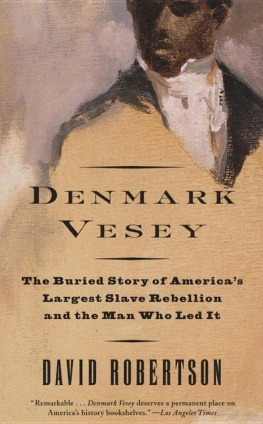Contents
Page List
Guide

Fugitive Movements
The Carolina Lowcountry and the Atlantic World
Sponsored by the Program in the Carolina Lowcountry and the Atlantic World of the College of Charleston
Black Freedom in the Age of Slavery: Race, Status, and Identity in the Urban Americas
John Garrison Marks
Challenging History: Race, Equity, and the Practice of Public History
Leah Worthington, Rachel Clare Donaldson, and John W. White, eds.
Paths to Freedom: Manumission in the Atlantic World
Rosemary Brana-Shute and Randy J. Sparks, eds.
The Impact of the Haitian Revolution in the Atlantic World
David P. Geggus, ed.
Fugitive Movements
Commemorating the Denmark Vesey Affair and Black Radical Antislavery in the Atlantic World
EDITED BY JAMES ONEIL SPADY
FOREWORD BY MANISHA SINHA
2022 University of South Carolina
Published by the University of South Carolina Press
Columbia, South Carolina 29208
www.uscpress.com
Manufactured in the United States of America
31 30 29 28 27 26 25 24 23 22
10 9 8 7 6 5 4 3 2 1
Library of Congress Cataloging-in-Publication Data can be found at http://catalog.loc.gov/.
ISBN 978-1-64336-265-6 (hardcover)
ISBN 978-1-64336-266-3 (ebook)
Publication of this book is made possible in part by the generous support of the Avery Research Center for the Study of African American History and Culture and the Program in the Carolina Lowcountry and Atlantic World at the College of Charleston.
A portion of Freedom Fighter or Attila the Hun? How Black and White Charlestonians Remembered Denmark Vesey, 18222014 originally appeared in Denmark Veseys Garden, copyright 2018 by Ethan J. Kytle and Blain Roberts. Reprinted by permission of The New Press. www.thenewpress.com
Front cover photograph: Denmark Vesey monument, Hampton Park, Charleston, SC. Photo by Brenda J. Peart, courtesy of Wikimedia Commons.
Front cover design by Daniel Benneworth-Gray
Contents
MANISHA SINHA
BERNARD E. POWERS JR.
JAMES ONEIL SPADY
ANITA RUPPRECHT AND CATHY BERGIN
LUCIEN HOLNESS
WENDY GONAVER
WILLIAM D. JONES
SHAWN HALIFAX AND TERRI L. SNYDER
SAMUEL NTEWUSU
ROBERT L. PAQUETTE
DOUGLAS R. EGERTON
BLAIN ROBERTS AND ETHAN J. KYTLE
Illustrations
)
)
)
)
)
)
)
)
)
)
)
)
Acknowledgments
This book began as a conference sponsored by the Carolina Lowcountry in the Atlantic World Program (CLAW) at the College of Charleston in 2019. I am grateful for Simon Lewis and Joe Kelleys suggestion that I put this together and for the financial support of the CLAW program and Soka University of America. I am also grateful for the editorial guidance, support, and suggestions offered by Ehren Foley at the University Press of South Carolina. The presss external reviewers gave important and useful suggestions for organization and themes. We have tried to implement many of them. The book is better as a result. Many thanks to my students, particularly Anthea Mudanye, Jordyn Saito, and Khin Thazin. My faculty and student colleagues in the African and Ethnic Studies campaign at Soka University of America have had a significant influence on this book as well. This book is dedicated to Denmark Vesey, his coorganizers, and all who risked harrowing consequences to struggle against racial chattel slavery.
Foreword
Slave resistance rather than bourgeois liberalism lay at the heart of the Transatlantic abolition movement. To understand this simple truism is to appreciate both the national as well as transnational significance of the Denmark Vesey Conspiracy of 1822. As James Spady adeptly argues in this book, we must view the Vesey conspiracy through the lens of a broader antislavery uprising in antebellum South Carolina. We must then reject conventional historiographical divisions between resistance by the enslaved and antislavery activism. In the United States, where over ninety percent of the African American population was enslaved before the Civil War, it means reckoning with the broader reach of Black radical antislavery that encompassed slave rebellions, fugitivity, and other forms of resistance to slavery. A capacious understanding of African American radicalism would include freedom suits, petitions, intellectual responses to the pseudoscience of race, the long fight against racial segregation and the criminalization of Blackness, autonomous institution building epitomized by Black churches, conventions, and fraternal societies, as well as an alternative historical genealogy of resistance and survival embedded in folk memory and Black popular culture.
This superb volume of penetrating essays on the Vesey affair and its ramifications at all these levels goes a long way in unearthing the hidden and silent archives of the Black antislavery Atlantic. Far from being passe, slave resistance has recently been conceptualized in theoretically sophisticated ways, opening new vistas of the African American radical political imaginary. Samuel Ntewusu, in this anthology, and I, in my book on abolition, have argued that the origins of Black radical antislavery lie in slave resistance in the west coast of Africa, often forgotten in histories of African participation in the slave trade. A range of activities in West Africa, more than just the African military antecedents of slave rebellions in the Americas, define slave resistance in the era of Vesey. They represent the start of the the Black antithesis to the slave trade and enslavement.
Transatlantic Black antislavery radicalism included not only Africa but also Europe, the Caribbean, and Latin America. James Sidbury recently recommended that we internationalize early African American history, and I have attempted to chart a Black abolitionist international. From Julius Scotts recently published and already iconic The Common Wind to Ifeoma Kiddoe Nwankos notion of Black cosmopolitanism, much of this work has emphasized the cross-fertilization of Black resistance in American slave societies. Inspired by Scott and C. L. R. Jamess classic, Black Jacobins, numerous historians of Black antislavery, including myself, have pointed to the pivotal place of the Haitian Revolution, an abolitionist revolution par excellence, in the Black and white abolitionist imagination. As Bernard Powers essay on Veseys conspiracy in South Carolina and other work on Gabriels and the German Coast rebellions in Virginia and Louisiana reveal, a case can be made for the formative influence of Haiti on slave rebellions not just in the slave societies of the Caribbean and South America but also in the United States. Veseys conspiracy is an essential part of this antislavery ferment in the age of revolution.
Recent historical literature on the United States has conceptualized Black antislavery radicalisms in theoretically sophisticated ways. Steven Hahn has reimagined northern free Black communities, with their fair share of slave runaways, whom the abolitionist William Lloyd Garrison called self-emancipated slaves, as maroon communities. In Spadys formulation and Wendy Gonavers article, fugitivity becomes a central trope to understand Black resistance to slavery. As Spady writes, All Black freedom movements are fugitive, and he reformulates Black antislavery as a fugitive social movement. His essay provides us with new interpretive and methodological tools to understand slave rebellions as antislavery that puts to rest the contrived controversy over whether Veseys conspiracy actually took place or was a figment of slaveholding state authorities imagination. In my own work, I discuss the importance of a new generation of fugitive slave abolitionists in the 1840s and 1850s in radicalizing an interracial abolition movement and moving it toward direct action. These freedom seekers also produced the movement literature of abolition, publishing their slave narratives under abolitionist auspices.







